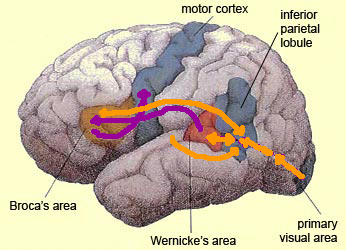4. The intertwinement of gesture and speech: Why a singer should be allowed gesticulating at all times.
I stated earlier in 1.5.2 that in my case it is probably better to involve my arms and hands in the process of finding a deeper connection to the text, in order to find a deeper physical connection in my expression. I found neurobiological evidence which supports this theory and therefore substantiates my believe that preventing the hands and arms from contributing to one’s expression is not the most effective way to connect in a physically deeper way with the meaning of a text. Hence, creating a method allowing both arms and hands to move in order to connect more intensely with the lyrics will provide a more convincing and natural performance on stage.
In the 18th century philosophers already tried to find a connection between gesture and speech. They had their theories about how gesture and speech came into existence. Giambattista Vico, an 18th century philosopher, formulated in his La Scienza Nuova (1744) the theory that humans in their early beginnings communicated through gesture and not by speech. Condillac (1746), a French philosopher, had the similar idea that language evolved not from animal calls, but from manual gestures. Later in the 1960’s and 70’s, studying gestures was part of ‘non-verbal communication research’, because gestures were seen as a form of non-verbal behaviour. This line of research, which is still active today, mainly focusses on the expression of bodily behaviour that speech cannot express. It also includes the study of other bodily behaviours (e.g. body-posture, gaze and facial expression). From 1980 onwards another field of research (called ‘gesture research’) developed, focussing more on how close gesture and speech are intertwined in creating word-meaning [10]. During the last decade other theories emerged forming two different ideas regarding the motoric systems in our brain, responsible for speech and gesture production. The first (older) theory declares that the communication systems of gesture (motor and premotor cortex [11])and speech (left perisylvian ‘language regions’ including Broca’s and Wernicke’s area [11])are different systems operating separately. According to this, gestures serve as a helping mechanism in moments where verbal expression for a short moment is interrupted or where the retrieval of words is difficult. These theories assume that gestures occur mainly when we encounter problems in our word production [15][a].
However, recent neuropsychological and neurophysiological research reveals (the second theory), that speech and gesture actually form a single communication system. This due to the fact that they are both linked to the same process of thinking, even if the modality of the expression differs. [15][13] Püllvermuller (2005) gives a brief description of the theory that, between the cortical motoric system and language system, pathways for collaboration are created by neural connections (according to experiments on monkey brains) [11]. In other words, the primary language pathway (see figure 1 [ purple lines] and 2) starts in the area of Wernicke where auditory and visual information is received and attribution in language comprehension takes place. The bundle of nerve fibres called the ‘arcuate fasciculus’ connects the area of Wernicke with Broca’s area [d].This area is responsible for (meaningful) language production and also plays a part in language comprehension [12]. Output from this region goes to the motor complex where complicated movements are created that are necessary for speech [d]. This observation makes it obvious that the motoric output of our speech (e.g. forming gestures) is part of the whole comprehension and utterance mechanism of words.
With the simplified explanation above, it may seem as if gesticulation only happens when Broca’s area sends impulses to the cortical motoric system. However, in theory the interaction between Broca’s area, the motoric system, and other parts of the brain, is much more complicated. There are many interactive connections between brain parts, creating a magnificent communication system. These connections and their function are still being discovered to this day.
Based upon these findings, however, the method of holding the hands and arms still in order to become physically more engaged with a text preferably should not be used by teachers. It seems to me that this approach counteracts the natural impulse of human expression. Gestures accompany our speech and both should be considered as integrated in one's way of communicating. If the brain works best according to this system, this should not be counteracted by training.
My method for finding a solution to the problem of making meaningless gestures during singing is thus based upon the assumption that speech and gesture are naturally integrated in human communication. They are of great value in emphasizing emotional expression. Therefore, seeking the right movements in practicing lyrics and melody strongly contributes to a convincing and credible performance in singing, rather than a static posture by not moving the arms, hands or any other body part

